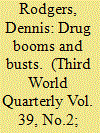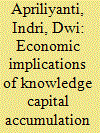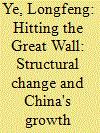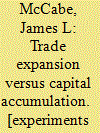| Srl | Item |
| 1 |
ID:
157722


|
|
|
|
|
| Summary/Abstract |
The income generated by the drug economy can often be substantial for the different parties involved, even at the lowest rung of this illicit trade. Yet the drugs trade is also a notoriously volatile activity, meaning that drug-related prosperity is highly prone to boom-and-bust cycles. Drawing on ongoing longitudinal ethnographic research in urban Nicaragua, this article explores the consequences of the cyclical nature of the drugs trade, tracing its unequal patterns of capital accumulation, as well as what happened to those who benefited from the drug economy when it became more exclusive and then subsequently moved on elsewhere.
|
|
|
|
|
|
|
|
|
|
|
|
|
|
|
|
| 2 |
ID:
133564


|
|
|
|
|
| Publication |
2014.
|
| Summary/Abstract |
Reviewing the experiences of japan, this paper analyzes factors that determine and shape the output generation. This article seeks to apply the Cobb Douglas production function, which is to analyze the contribution of each input in a set of combined factor inputs, by examining which factor input amongst research activities, labor or capital has a larger influence on output. The dynamic of output is measured in integrated factors, and the progress in understanding the output source will improve the computation of Cobb Douglas production function, which is the objective of this study. Data obtained from Research Institute of Economy, Trade and Industry (RII.*l'I'I) japan Industrial Productivity GIP) Database 2011 and Japan Statistics Official in the period of 1970 to 2008 are used to test the hypotheses. Multiple regression method was conducted. The ?ndings of this study provide substantial lessons for Indonesia, particularly with regards to the improvement of the industrial policy regarding innovation and technology.
|
|
|
|
|
|
|
|
|
|
|
|
|
|
|
|
| 3 |
ID:
168357


|
|
|
|
|
| Summary/Abstract |
China is facing slowing growth rates, slowing rates of rural to urban migration and resistance to reforms that would liberalize internal migration restrictions (Hukou). We use a two sector Ramsey growth model and show that, allowing for endogenous capital accumulation, labour reallocation has accounted for approximately one fifth of China's per capita GDP growth over the last 30 years, and that Hukou reform could generate a significant boost to China's per capita GDP growth over the next decade. Our results contrast with conclusions drawn from the traditional growth accounting literature on labour reallocation effects in China because our simulation method allows for endogenous capital accumulation dynamics.
|
|
|
|
|
|
|
|
|
|
|
|
|
|
|
|
| 4 |
ID:
143415


|
|
|
|
|
| Publication |
Cambridge, Harvard University, 1970.
|
| Description |
42p.pbk
|
| Series |
Economic Development Report no.; 161
|
|
|
|
|
|
|
|
|
|
|
|
Copies: C:1/I:0,R:1,Q:0
Circulation
| Accession# | Call# | Current Location | Status | Policy | Location |
| 012498 | 931.04/MCC 012498 | Main | On Shelf | Reference books | |
|
|
|
|